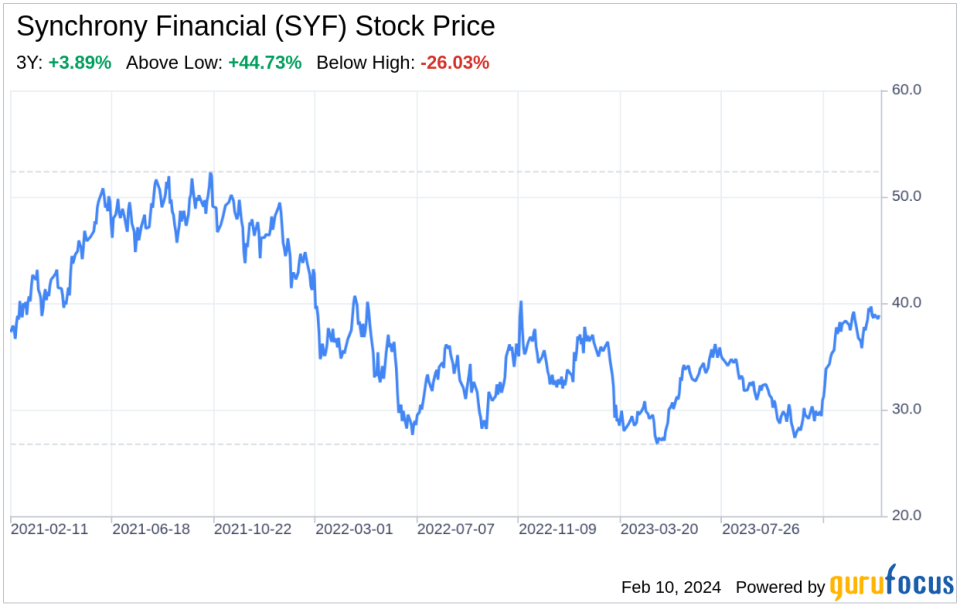Decoding Synchrony Financial (SYF): A Strategic SWOT Insight
Strengths highlight Synchrony Financial's robust digital capabilities and expansive partner network.
Weaknesses underscore potential risks from regulatory changes and competitive pressures.
Opportunities emphasize the potential for growth through technological innovation and market expansion.
Threats include the evolving landscape of consumer financing and the intensifying competition.
On February 8, 2024, Synchrony Financial (NYSE:SYF), a leader in consumer financial services, released its 10-K filing, revealing a comprehensive overview of its operations and financial health. As the largest provider of private-label credit cards in the U.S., Synchrony Financial boasts a significant market presence, underscored by its strategic partnerships and innovative digital solutions. The company's financial tables reflect a solid balance sheet, with a notable increase in active accounts and purchase volume, indicating a strong customer engagement and retention strategy. This SWOT analysis delves into the strengths, weaknesses, opportunities, and threats as presented in the latest SEC filing, providing investors with a detailed perspective on Synchrony Financial's market position and future prospects.

Strengths
Robust Digital Ecosystem and Partner Network: Synchrony Financial's strength lies in its comprehensive, digitally-enabled product suite, which caters to a wide array of industries. The company's established network of partners, including national and regional retailers, local merchants, and healthcare providers, forms the backbone of its business model. This network, combined with Synchrony's digital capabilities, facilitates seamless omnichannel experiences for consumers, driving engagement and loyalty. The filing highlights the company's successful Quickscreen acquisition method, which outperforms traditional channels in response rate and spending, showcasing the effectiveness of Synchrony's digital strategies.
Marketing Expertise and Data Analytics: Synchrony Financial's marketing teams possess deep expertise in omnichannel strategy, driving qualified traffic and attracting new customers. With over 73 million active accounts, the company leverages its data analytics capabilities to optimize customer relationships and fuel targeted marketing campaigns. The filing indicates that approximately 60% of CareCredit's purchase volume in 2023 stemmed from repeat usage, demonstrating the efficacy of Synchrony's customer retention efforts.
Weaknesses
Regulatory and Compliance Risks: As a financial institution, Synchrony Financial is subject to stringent regulatory oversight, which poses a significant weakness. Changes in banking laws, regulations, and enforcement practices can adversely impact the company's operations and profitability. The filing acknowledges the potential for increased compliance costs and limitations on product offerings due to evolving privacy, data protection, and information security laws. These regulatory challenges could constrain Synchrony's ability to innovate and expand its services.
Operational Dependencies: Synchrony Financial relies on third-party vendors and service providers for various operational aspects. The filing expresses concerns over the risks associated with these dependencies, including potential service disruptions and increased regulatory scrutiny over third-party relationships. Such dependencies could lead to operational inefficiencies and heightened vulnerability to system failures or data breaches, which may adversely affect Synchrony's reputation and financial performance.
Opportunities
Technological Advancements and Product Innovation: The evolving consumer finance landscape presents significant opportunities for Synchrony Financial to capitalize on technological advancements. The company's focus on product development, as evidenced by the expansion of its Pay Later solution, positions it to meet the changing needs of consumers and retailers. By continuing to innovate and enhance its product offerings, Synchrony can secure a competitive edge and tap into new market segments.
Market Expansion and Strategic Partnerships: Synchrony Financial's established partner network provides a foundation for market expansion. The company's strategy includes building relationships with tech-enabled platforms and integrating its offerings to attract new merchants. By leveraging its marketing and data analytics expertise, Synchrony can expand its reach and foster strategic partnerships, driving growth and diversification.
Threats
Competitive Landscape and Market Disruption: The consumer credit and payments industry is highly competitive, with new technologies and players constantly entering the market. Synchrony Financial faces threats from non-bank providers of pay-over-time solutions and larger technology companies venturing into financial products. The filing notes the risk of customer attrition and the need to adapt to digital wallet technologies, which could impact the company's market share and profitability.
Macroeconomic and Regulatory Changes: Macroeconomic fluctuations and regulatory changes pose threats to Synchrony Financial's business model. Interest rate volatility, credit risk management, and capital adequacy requirements are among the financial risks highlighted in the filing. Additionally, the company must navigate the complex regulatory environment, which can lead to increased costs and restrictions on business activities, potentially hindering growth and affecting the bottom line.
In conclusion, Synchrony Financial (NYSE:SYF) presents a compelling case of a company with strong digital capabilities and a robust partner network, poised to leverage its strengths in a competitive market. However, it must navigate regulatory complexities and operational risks while capitalizing on technological innovations and market expansion opportunities. The threats from an evolving industry landscape and competitive pressures underscore the need for strategic agility and proactive risk management. This SWOT analysis provides a nuanced understanding of Synchrony Financial's position, informing investors of the challenges and prospects that lie ahead for the company.
This article, generated by GuruFocus, is designed to provide general insights and is not tailored financial advice. Our commentary is rooted in historical data and analyst projections, utilizing an impartial methodology, and is not intended to serve as specific investment guidance. It does not formulate a recommendation to purchase or divest any stock and does not consider individual investment objectives or financial circumstances. Our objective is to deliver long-term, fundamental data-driven analysis. Be aware that our analysis might not incorporate the most recent, price-sensitive company announcements or qualitative information. GuruFocus holds no position in the stocks mentioned herein.
This article first appeared on GuruFocus.
